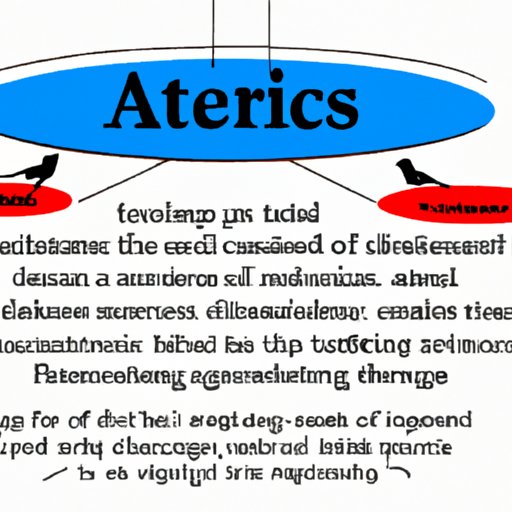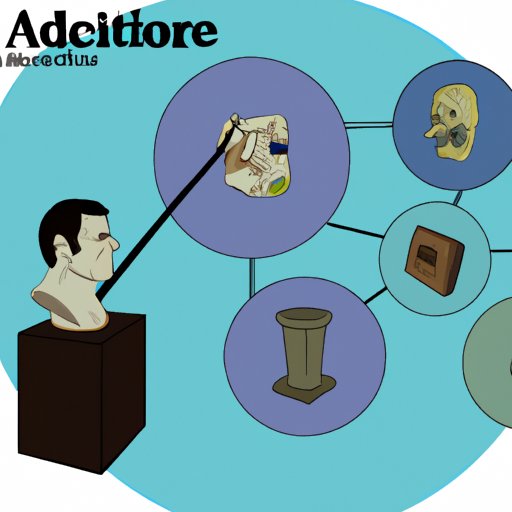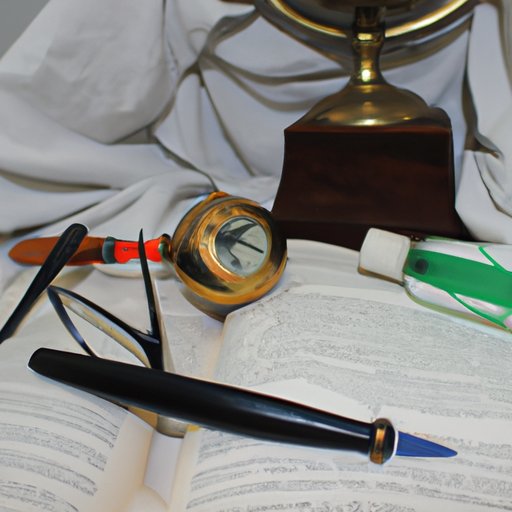Introduction
An artifact is an object that is created by humans for a specific purpose. In literature, artifacts are used by authors to represent characters, evoke emotions, and move the plot forward. Through the use of artifacts, authors can create a sense of place, convey symbolism and metaphor, and develop characters in a unique and meaningful way. This article will explore how authors use artifacts in literature and examine their impact on character development and plot structure.

Analyzing the Symbolic Meaning of Artifacts in Literature
Artifacts often carry symbolic meaning in literature. By using objects as symbols, authors can represent characters and themes without explicitly stating them. Identifying the symbolism behind artifacts can help readers gain a better understanding of the text and uncover the deeper meanings within it.
Identifying Symbolism in Artifacts
When analyzing artifacts in literature, it’s important to consider the context in which they are used. For example, if an author uses a particular type of flower to represent a character, then the color and shape of the flower can provide clues about the character’s personality or backstory. Similarly, an author may use a specific weapon to represent a theme or concept. By examining the details of the object, readers can begin to identify the symbolism behind the artifact.
Exploring the Deeper Meaning Behind the Artifact
Once readers have identified the symbolism behind an artifact, they can explore the deeper meaning behind it. For example, if a character is associated with a particular type of flower, readers can consider what that flower represents and how it relates to the character. Additionally, readers can think about how the artifact is used in the text and how it contributes to the overall story. By exploring the deeper meaning behind artifacts, readers can gain a better understanding of the text and the author’s intentions.

Examining the Role of Artifacts in Character Development
Artifacts can be used by authors to develop characters and reveal more about them. By examining the role of artifacts in character development, readers can gain insight into a character’s motivations, desires, and struggles.
Using Artifacts to Show Internal Struggles
Authors often use artifacts to show a character’s internal struggles. For example, a character might wear a particular type of clothing to hide their true feelings or carry a certain type of weapon to symbolize their desire for power. By examining the artifacts a character uses, readers can gain insight into their inner conflict and understand more about their motivations.
Analyzing the Impact of Artifacts on Character Motivation
Artifacts can also be used to reveal a character’s motivations. For example, a character might carry a particular type of book to signify their interest in a certain topic or wear a certain type of jewelry to express their loyalty to a cause. By examining the artifacts a character uses, readers can gain insight into their motivations and understand more about their character arc.
Exploring the Use of Metaphorical Artifacts
Artifacts can also be used by authors to convey metaphors. Metaphors allow authors to make comparisons between two seemingly unrelated things and can be used to make a point or emphasize a theme. By understanding how metaphors work and examining examples of metaphorical artifacts, readers can gain a better understanding of the text and its underlying message.
Understanding How Metaphors Work
Metaphors are a type of figurative language that compares two unlike things without using the words “like” or “as.” For example, an author might say “the sky is a blanket of stars” to compare the night sky to a blanket. In literature, authors often use artifacts as metaphors to represent ideas or concepts. By understanding how metaphors work, readers can identify the metaphorical meaning behind artifacts and gain a better understanding of the text.
Examining Examples of Metaphorical Artifacts
When examining metaphorical artifacts, it’s important to consider the context in which they are used. For example, an author might use a particular type of tree to represent a character’s strength and resilience. Alternatively, an author might use a specific type of bird to symbolize freedom and independence. By examining examples of metaphorical artifacts, readers can gain a better understanding of the text and its underlying message.
Investigating the Function of Artifact References in Plot Development
Artifacts can also be used by authors to move the plot forward and reveal more about characters. By understanding how artifacts are used to develop plots and characters, readers can gain a better understanding of the text and its narrative structure.
Understanding How Artifacts Move the Story Forward
In literature, artifacts can be used to move the plot forward and reveal information about characters. For example, a character might find a specific type of object that reveals a hidden truth or a clue that leads them to a new destination. By understanding how artifacts are used to move the story forward, readers can gain a better understanding of the text and its narrative structure.
Examining How Artifacts Reveal More About Characters
Artifacts can also be used to reveal more about characters. For example, a character might carry a particular type of object to symbolize their past or wear a specific type of clothing to express their identity. By examining how artifacts are used to reveal more about characters, readers can gain a better understanding of the text and its characters.

Understanding How Artifacts Create a Sense of Place in Literary Works
Artifacts can also be used by authors to create a sense of place in literary works. By understanding how artifacts are used to create atmosphere and emotion, readers can gain a better understanding of the text and its setting.
Examining How Artifacts Set the Scene
In literature, artifacts can be used to set the scene and create a vivid picture of the setting. For example, an author might use a particular type of furniture to evoke a certain era or a specific type of clothing to signify a certain culture. By examining how artifacts are used to set the scene, readers can gain a better understanding of the text and its setting.
Analyzing How Artifacts Evoke Emotions
Artifacts can also be used to evoke emotions in readers. For example, a character might carry a particular type of object to signify their sorrow or wear a specific type of clothing to express their joy. By analyzing how artifacts evoke emotions, readers can gain a better understanding of the text and its emotional content.
Conclusion
This article has explored how authors use artifacts in literature to represent characters, evoke emotions, and move the plot forward. It has examined how artifacts can be used to symbolically represent characters and themes, develop characters, and create a sense of place. By understanding how artifacts are used in literature, readers can gain a better understanding of the text and its underlying message.
In conclusion, artifacts are powerful tools that authors can use to create meaningful and powerful stories. By examining how artifacts are used in literature, readers can gain a better understanding of the text and its narrative structure. Additionally, by identifying the symbolism behind artifacts, readers can uncover the deeper meaning behind the text and gain insight into the author’s intentions.
Summary of Findings
This article has explored how authors use artifacts in literature to represent characters, evoke emotions, and move the plot forward. It has examined how artifacts can be used to symbolically represent characters and themes, develop characters, and create a sense of place. Additionally, it has discussed how artifacts can be used to convey metaphors and evoke emotions in readers.
Suggestions for Further Study
Further research could examine the impact of artifacts on other areas of literature, such as poetry and drama. Additionally, researchers could explore the role of artifacts in different genres of literature, such as fantasy, science fiction, and historical fiction. Finally, studies could be conducted to analyze how different cultures use artifacts in literature and how this affects the interpretation of texts.
(Note: Is this article not meeting your expectations? Do you have knowledge or insights to share? Unlock new opportunities and expand your reach by joining our authors team. Click Registration to join us and share your expertise with our readers.)
